
In a dramatic revelation, a hidden report from a 2018 Pentagon fly-off pitting the F-35 Lightning II against the A-10 Thunderbolt II in their respective combat roles has finally come to light. Released following a Freedom of Information Act (FOIA) request, the document illustrates the complexities and constraints of modern air support without declaring a definitive victor, suggesting instead that a combination of the F-35’s advanced technology and the A-10’s robust capabilities could offer the best solution in combat scenarios.

The fly-off, conducted to determine if the F-35 could effectively replace the A-10’s traditional roles, particularly focused on Close Air Support (CAS), Forward Air Controller Airborne (FAC(A)), and Combat Search and Rescue (CSAR). Despite the ambitious intent behind the comparison, the results, heavily redacted for national security reasons, left no clear impression of superiority for either aircraft. It appeared the tests did not fully realize the envisioned head-to-head matchup, especially considering the absence of ground troops, which prevented a genuine assessment of the F-35’s support capabilities in an engaged-combat context.

The secrecy surrounding the report – it wasn’t written until four years after the tests and only disclosed following legal action – fueled speculation that the results were not in favor of the F-35. If the fifth-generation stealth jet had indeed outperformed the A-10, it stands to reason such findings would have been heralded rather than obscured.As POGO asserts, that the “results were apparently not what the Air Force’s leaders expected, because they fought to hide them completely for years.”

From what could be discerned in the unredacted sections, the A-10C demonstrated its well-known strengths. Designed with a large ammunition capacity to support ground forces, its ability to carry 16 GBU-39 small diameter bombs and deliver 1,350 rounds from its GAU-8 cannon starkly contrasts with the F-35A’s capacity for only eight bombs and 181 rounds from its less accurate 25mm cannon. Tactics allowed A-10C pilots to fly closer to targets, leveraging the aircraft’s armored protection and redundancy to withstand damage – a clear advantage over the F-35A’s reliance on high-altitude flight and stealth.

The F-35’s challenges extend beyond the fly-off. A September 2023 Government Accountability Office report painted a grim picture of the F-35 fleet’s readiness rates, with a full mission capable rate of less than 50%. This raises concerns about the F-35’s ability to maintain a consistent presence in the skies compared to the rugged and reliable A-10.

In an enlightening yet redacted glimpse into pilot preferences, the report mentioned both F-35A and A-10C pilots acknowledging the potential synergies of operating in tandem during contested missions. It intimates a recognition that combining the F-35’s advanced systems with the A-10’s proven capabilities could enhance mission outcomes – a far cry from the initial Air Force narrative of the F-35 as a solitary successor to the A-10.

“A frequent comment by both F-35A and A-10C pilots during debriefings was the synergies that would occur if A-10C formations operated with F-35A escort during contested CSAR missions. This would combine the strengths of both platforms while mitigating their limitations to improve the likelihood of mission success,” the report states.

Despite the substantial obfuscation of the report’s content, the underlying message is clear: no solitary winner emerged from the 2018 fly-off. As the Air Force continues to plan the A-10’s retirement, this report adds a layer of complexity to the decision, suggesting that the future of effective combat air support may well rest on the wings of both these diverse aircraft working in concert rather than in competition.
related images you might be interested.








